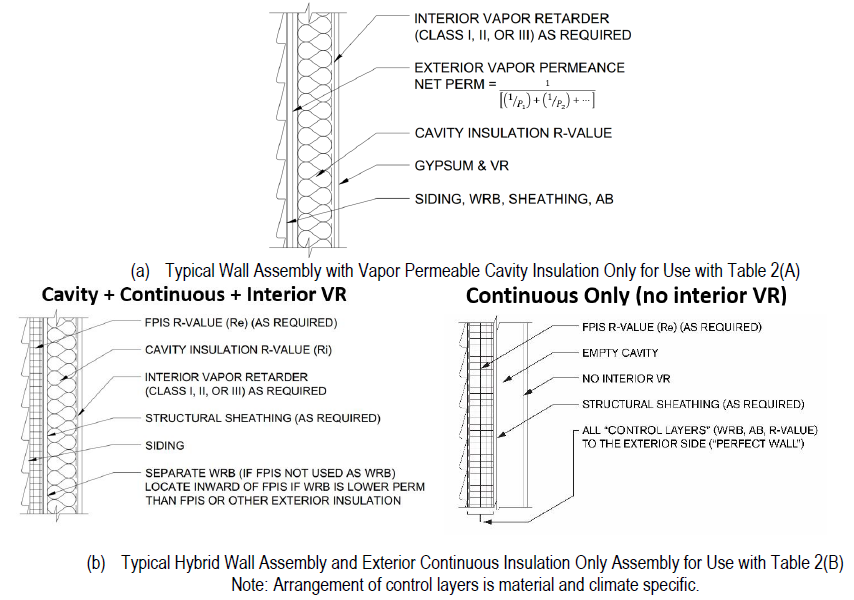In an earlier article we explained how the code defines cavity and continuous insulation. Cavity insulation goes between (and is interrupted by) framing whereas continuous insulation is continuous and not interrupted by framing other than fasteners or service openings. In general, there are three ways of using cavity and continuous insulation materials, to varying degrees, to provide thermal control for light-frame exterior walls (see Figure 1):
- cavity insulation alone,
- cavity and continuous insulation together (i.e., a ‘hybrid’ wall) or
- continuous insulation alone (the so-called ‘perfect’ wall).

Figure 1. Three Insulation Approaches for Thermal Control of Light-Frame Exterior Walls
Source: http://www.appliedbuildingtech.com/rr/1701-01 includes access to design recommendations in Tables 2(A) and 2(B) referenced in the above figure.
The insulation strategy selected – where to locate insulation in the wall to comply with the energy code – is in many ways a foundational decision because it affects other decisions related to matters of building code compliance. For example, the insulation strategy and properties of those materials should affect decisions regarding the specification of vapor retarders (vapor control layer) and even the water-resistive barrier (water control layer) depending on the properties of those layers and the climate. Cladding specification and installation details also may be affected, such as fastening methods and provision for drainage or back-ventilation to control moisture. For commercial Type I, II, III, or IV buildings, it can also affect wall assembly details and material specifications to achieve code compliant fire safety. These are not difficult decisions or hard to achieve. It is simply a matter of knowing that these inter-relationships exist and executing them effectively.
You see, we are dealing with a highly integrated system of several individual, and sometimes multi-functional, components. Consequently, these component parts of an exterior wall system have important interactions or inter-dependencies with other components in the system. These must be properly managed or coordinated to capitalize on strengths and avoid weaknesses. When done well, the whole is better than the sum of the parts. When not done well, the whole is no better than the worst of the parts.
We can no longer get away with treating the design and construction of walls as a series of independent component specification decisions. We need to get this system thing right in codes and in practice. Why? The answer is simple and we need not look any further than the intent of the building code:
“R101.3 Intent. The purpose of this code is to establish minimum requirements to safeguard the public safety, health and general welfare through affordability, structural strength, … energy conservation and safety to life and property from fire and other hazards attributed to the built environment…”
The issue here is not so much that the code is aimed at minimum requirements, but that the code and practice must also facilitate how those minimum requirements are implemented from a system-based design standpoint with inter-relationships between various minimum requirements properly coordinated so as to achieve the full intent of the code. It also is not so much a change in cost of construction as it is a more cost-effective approach to construction planning and specification. To the extent that this goal is achieved, more benefits are leveraged in the execution of a minimum code at little to no additional cost. These benefits include qualities such as durability and resiliency. It also helps to ensure that the flexibility to competitively use a variety of alternative solutions to specific energy and building code requirements remain available while avoiding inadvertent or unexpected outcomes.
In general, building codes do strive to effectively address matters of integrated system-based design (e.g., see “Fire Safety and Foam Sheathing Use” as a positive example of coordinating an energy code insulation choice with fire safety requirements of the building code). In other cases, such as matters related to moisture control and its effect on durability, these inter-relationships may not be completely accounted for. Fortunately, codes are continually improving and this is exhibited by a major step forward in the 2021 editions of the IBC and IRC to more completely address the inter-relationships between insulation strategy and water-vapor retarder strategy.